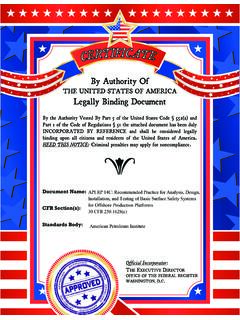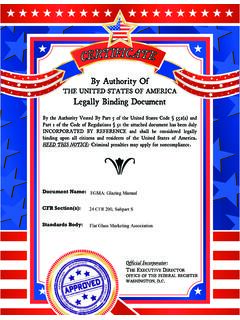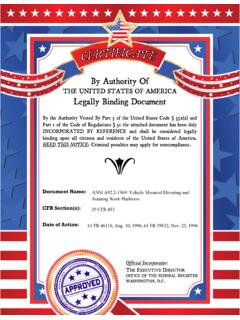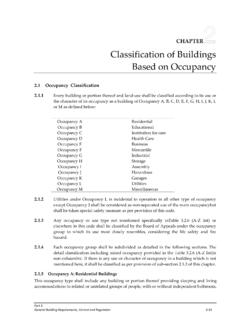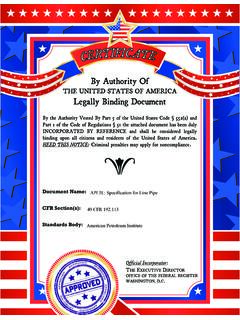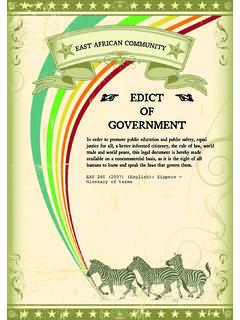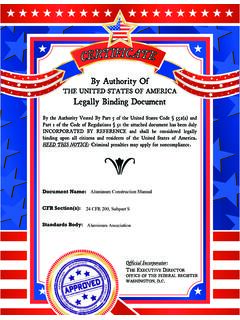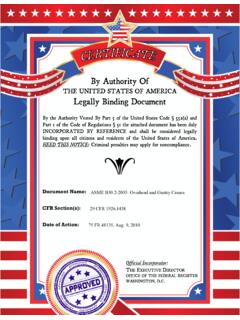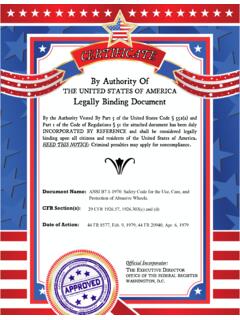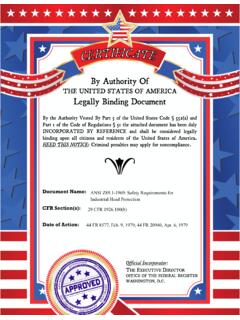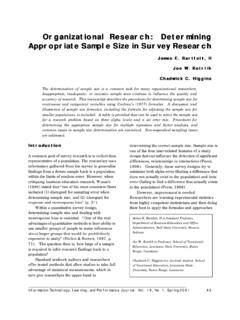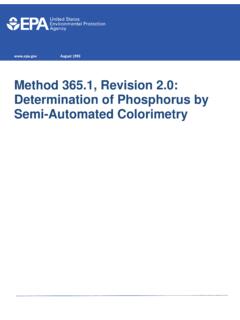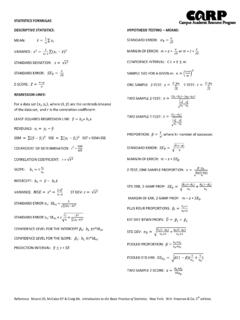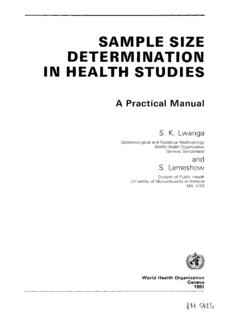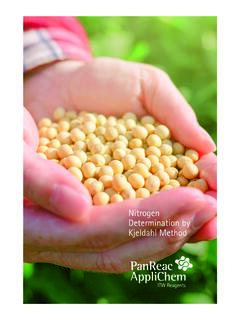Transcription of IS 2720-8 (1983): Methods of test for soils, Part 8: …
1 Disclosure to Promote the Right To InformationWhereas the Parliament of India has set out to provide a practical regime of right to information for citizens to secure access to information under the control of public authorities, in order to promote transparency and accountability in the working of every public authority, and whereas the attached publication of the Bureau of Indian Standards is of particular interest to the public, particularly disadvantaged communities and those engaged in the pursuit of education and knowledge, the attached public safety standard is made available to promote the timely dissemination of this information in an accurate manner to the public. ! $ ' + - Satyanarayan Gangaram Pitroda Invent a New India Using Knowledge 0 1 ' 5 Jawaharlal Nehru Step Out From the Old to the New 1 + , 1 + Mazdoor Kisan Shakti Sangathan The Right to Information, The Right to Live ! > 0 B Bhart hari N ti atakam Knowledge is such a treasure which cannot be stolen Invent a New India Using Knowledge IS 2720-8 (1983): Methods of test for soils, Part 8: determination of water content-dry density relation usingheavy compaction [CED 43: Soil and Foundation Engineering]IS : 2720 (Part 8)-l 983 Indian Standard /L_qpNJ /?
2 W Methods OF TEST FOR SOILS PART 8 determination OF WATER CONTENT-DRY DENSITY RELATION USING HEAVY COMPACTION ( Second Revision ) Second Reprint SEPTEMBER 1994 UDC 624, * *131*431~5 Q Copyrighr 1984 BUREAU OF INDIAN STANDA RDS MANAK BHAVAN, 9 BAHADUR SHAH ZAFAR MARG NEW DELHI 110002 Gr 3 February 1984 IS : hdian Standard 2720 ( Part 8 ) - 1983 Methods OF TEST FOR SOILS FART 8 determination OF WATER CONTENT - DRY DENSITY RELATION USING HEAVY COMPACTION ( Second Revision ) Soil Engineering and Xock Mechanics Sectional Committee, BDC 23 Repcrcnfirrg \ssociation of Indian Univcrsirirs, Sew Delhi Public Works Drpartmrnt, of Uttar Pradesh, Lucknow University of Jodhpur, Jodhptlr Enginet,ring Research Laboratorit>s, Governmc,nt of Andhra Pradesh, Hyderabad Concrete Association of India, Bombay Irrigation Department, Govrrnment of Pllnjab, Chandigarh In personal capacity (5 Hungcrford Court, 12 1, Hungerford Street, Calncttu ) lndian Geotechnical Society, New Delhi Central Soil & Mattyrials Research Station, NI*W Delhi Irrigation Department, Government of Uttar Pradesh, Roorkee Asia Foundations and Construction (P) Ltd, Born bay University of Roorkee, Roorkec; and Institute of Engineers ( India ), Calcutta \Cemindia Cornpany Limited, Bombay SHRI iY.
3 V. DE-Sous. ( Alternate ,I ( Continued on pngc 2 ) Q Copyright 1984 BUREAU OF INDIAN STANDARDS This publication is protected rmdrr the Indian Cepyrighf AC: ( XIV of 1957 ) and reproduction Fn whole or in part by any means except with written permission of the publisher shall be deemed to be an infringement of coDvrieht under the said Act. I IS : 2720 ( Part 8) - 1983 ( Continuedfrom page 1 ) Members Representing St5n1 M. IYENQA~ SRRI ASHOE K. JAIN Engineers India Limited, New Delhi SHRI VIJAY K. JAIN ( Alternate ) G. S. Jain and Associates, Roorkee JOINT DIRECTOR RESXARCH (GE)-I, Ministry of Railways RDSO JOINT DIRECTOR RESEARCH (GE)-11 RDSO ( Afternale ) LT-COL V. K KANITKAR SH~I OP. MALJXOTRA Engineer-in-Chief s Branch, Army Headquarters Public Works Department, Chandigarh Adminis- SHR~ D. R. NARAHARI tration, Chandigarh Central Building Research Institute ( CSIR ), Roorkee S II~I V. S. A~ARWAL ( Alfernate ) SHK~ T. K. NATRAJAN Centr$pad Research Institute ( CSIR ), New SHRI RANJIT SINGH Ministry of Defence ( R & D ) SHRI P.)
4 D. DESHPAN~E ( Alternate ) DR G. B. RAO Indian Institute of Technology, New Delhi DR K. K. GUPTA ( Alternate ) REEEARC~ OFFICER ( B & RRL ) Public Works Department, Government of Punjab, SECRETARY Chandigarh - Central Board of Irrigation and Power, New Delhi D~ SECRETARY ( dlfernatc ) SE%1 N. SIVAoUnU Roads Wing ( Ministry of Shipping and Transport ) SHHI P. R. KALRA ( Altcrnafe 1 San1 K. S. SRINIVASAN SHRI SUNIL BERRY ( Altsrnute ) DR N. SOM SERI N. SVBRAMANYAM National Buildings Organization, New Delhi SUP~RINTI~ND~N~ ENGINEER ( P SC DC) Jadavpur University, Calcutta Karnataka Engineering Research Station, Krishnarajasagar Public Works Department, Government of Tamil Nadu, Madras . EXECUTIVE ENGINEER ( SMRD) ( Alternote ) SHRI H. C. VERMA All India Instrument Manufacturera and Dealers SHRI H. K. GUHA ( Alternate ) Association, Bombay SRRI G. RAMAN, Director General, ISI ( Ex-ojicio Member ) Director ( Civ Engg ) Secrelav Sam K. M. MATHUR Senior Deputy Director ( Civ Engg ), IS1 Soil Testing Procedures Subcommittee, BDC 23 : 3 Convener DR ALAM SINQH University oft Jodhpur, Jodhpur &nber~ SHRI AYAK SrNQH Centr$or~~lding Research Institute ( CSIR ), 3~~1 M.)
5 -R. Sonlur ( lf~errto#r ) ( Confinurd en #age 9 ) 2 Indian Methods OF PART 8 determination OF WATER CONTENT -- DRY DE-NSITY RELATION USING HEAVY COMPACTION IS : 2720 ( Part 8 ) - 1983 Standard TEST FOR SOILS (Second Revision ) 0. FOREWORD This Indian Standard ( Second Revision ) was adopted by the Indian Standards Institution on 28 November 1983, after the draft finalized by the Soil Engineering and Rocks Mechanics Sectional Committee had been approved by the Civil Engineering Division Council. Purpose of a laboratory compaction test is to determine the proper amount Df mixing water to be used, when compacting the soil in the field and the resulting degree of denseness which can be expected from compaction at optimum moisture content. To accomplish this, a laboratory test which will give a degree of compaction comparable to that obtained by the field method used is necessary. This procedure is satisfactory for cohesive soils but does not lend itself well to the study of the compaction characteristics of clean sands or gravels which displace easily when struck with rammer.
6 Some nearly cohesionless soils compact satisfactorily in the standard test although in many cases the water density curiae is not well defiued. Frequently, too in these cases indicated, maximum density is not as great as can be achieved readily in the field under available conlpaction Methods . With a knowledge of the water density relation as determined by this test, better control of the field compaction of soil fill is possible because the optimum moisture content and the density which should be obtained are known by using this test procedure and these can be checked by field control tests. This part which was first published in 1965 and revised in I974 covers the method of test based on heavy compaction. The method of test based on light compaction is covered in IS : 2720 ( Part 7 )-1 ~80*. This revision is prepared so as to cover such cases when soil could be susceptible to crushing ~during compaction. For the purpose of deciding whether a particular requirement of this standard is complied with, the final value, observed or calculated, * Methods of test for soils : Part 7 determination of water content.
7 -dry densit\ relation using light compaction ( secondrecision ). 3 fS : 2720 ( Part 8 ) - 1983 expressing the resuit of a test or analysis, shall be rounded off in accordance with IS : 2-1960 . The number of significant places retained in the rounded off value should be the same as that of the specified value in this standard. 1. SCOPE This standard ( Part 8) lays down the method for the determination of the relation between the water content and the dry density of soils using heavy compaction. 2. TERMINOLOGY For the purpose of this standard, the definitions given in IS : 2809- 19727 shall apply. 3. APPARATUS Cylindrical Metal Mould - It shall be either of 100 mm diameter and I 000 cm3 volume or 150 mm diameter, and 2 250 cm3 volume and shall conform to IS : 10074-1982:. Sample Extruder ( ) - It consists of a jack, lever frame or other device adopted for the purpose of extruding compacted specimens from the mould. Balances - One of 10 kg capacity sensitive to 1 g, and other of 200 g capacity and sensitive to 0 01 g.
8 Oven -Thermostatically controlled, with interior of non-corroding material to maintain temperature between 105% and 110 C. Container - Any suitable non-corrodible airtight container to determine the water content for tests conducted in the laboratory. Steel Straightedge - A steel straightedge about 30 cm in length and having one bevelled edge. Sieve - 4*75-mm, 19-mm and. mm IS sieves conforming to IS: 460 ( Part I )-1978s. *Rllles for roundirlg off numerical values ( revised). ~Glossary ofterms and symbols relating to soil engineering (jirst revision ). ;Specification for compaction mould assembly for light and heavy compaction of soils. $Specification for test sieves: Part 1 Wire cloth test sieves ( srcond revirion ). 4 IS : 2720 ( Part 8) - 1983 Mixing Tools - Miscellaneous tools, such as tray or pan, spoon, trowel and spatula, or a. suitable mechanical device for thoroughly mixing the sample of soil with additions of water. Metal Rammer - Heavy compaction rammer conforming to IS : 9 189-1979*.
9 4. SOIL SPECIMEN A representative portion of air-dried soil material and large enough to provide about 6 kg of material passing a 19-mm IS sieve (for soils not susceptible to crushing during compaction ), or about 15 kg of material passing a 19 mm IS sieve ( for soils susceptible to crushing during compaction ), shall be taken ( see Note ). This portion shall be sieved on a 19 mm IS sieve and the coarse fraction rejected after its proportion of the total sample has been recorded. ~NOTR -The soil should be considered susceptible to crushing during comtxrction if the samole contains granular material of a soft nature. such as soft lime stone, sandstone, etc , I which ii reduced in size by the action of the rammer. The procedure given in for soils susceptible to crushing during compaction can be applied to all soils if it is convenient to do so. Aggregations of particles shall be broken down so that if the sample was sieved on a IS sieve, only separated individual particles would be retained.
10 5. PROCEDURE Soil Not Susceptible to Crushing During Compaction ( see Note under ) - The procedure is as follows: A 5-kg sample of air dried soil passing the 1%mm IS test sieve shall be taken (see Note 1 ). The sample shall be mixed thoroughly with a suitable amount of water depending on the soil type ( see Notes 2 and 3 ). The mould, of 1 000 cm3 capacity with baseplate attached, shall be weighed to the nearest 1 g ( m, ). The mould shall be placed on a solid base, such as a concrete floor or plinth and the moist soil shall be compacted into the mould, with the extension attached, in five layers of approximately equal mass, each layer being given 25 blows from the 4*9-kg rammer droped from a height of 450 mm above the soil. The blows shall be distributed uniformly over the surface of each layer. The operator shall ensure that the tube of the rammer is kept clear of soil so that the rammer always falls freely. The amount of soil *Specification for compaction rammer for soil testing.
